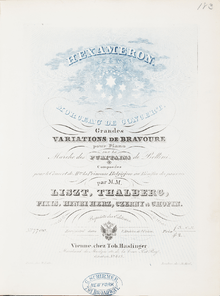Hexameron (musical composition)

Hexaméron, Morceau de concert, S.392, is a collaborative work for solo piano, consisting of six variations on a theme, along with an introduction, connecting interludes and a finale. The theme is the "March of the Puritans" from Vincenzo Bellini's opera I puritani. The piece was conceived in 1837 by the Princess Belgiojoso, who persuaded Franz Liszt to assemble a set of variations of the March among with five of his pianist-friends. Liszt composed the introduction, the second variation, the connecting sections and the finale, and integrated the piece into an artistic unity, while the other popular composer-performers of the day contributed with a variation each: Frédéric Chopin, Carl Czerny, Henri Herz, Johann Peter Pixis and Sigismond Thalberg.
Hexameron was commissioned for a benefit concert for the poor, taking place on 31 March 1837 at the Paris salon of Princess Cristina Trivulzio Belgiojoso.[1] The piece was not completed on time, but nevertheless the concert was the place where Thalberg and Liszt had their famous 'piano duel' for the title of "greatest pianist in the world." Princess Belgiojoso’s famous judgment was: "Thalberg may be the first pianist in the world, but Liszt is the only one."
Hexameron is divided into nine parts:
- Introduction: Extremement lent (Liszt)
- Tema: Allegro marziale (transcribed by Liszt)
- Variation I: Ben marcato (Thalberg)
- Variation II: Moderato (Liszt)
- Variation III: di bravura (Pixis) - Ritornello (Liszt)
- Variation IV: Legato e grazioso (Herz)
- Variation V: Vivo e brillante (Czerny) - Fuocoso molto energico; Lento quasi recitativo (Liszt)
- Variation VI: Largo (Chopin) - (coda) (Liszt)
- Finale: Molto vivace quasi prestissimo (Liszt)
The piece has been notably recorded by Raymond Lewenthal, Leslie Howard, Francesco Nicolosi and Marc-André Hamelin among others. The word "Hexameron" itself refers to the biblical six days of creation.
In addition to the solo piano version, Liszt made arrangements for piano and orchestra (S.365b), and two arrangements for two pianos (S.654) (both shorter than the solo and orchestral versions, and one with a completely re-written ending).
More recently, a solo-piano work with the same name and based on the same Bellini theme as the work above was created in 2009 by six New York-based composer-pianists, and was given its premiere at the 2010 American Liszt Society Festival in Nebraska, USA. It is similar in structure to the original Hexameron, consisting of an introduction, theme, six variations with connecting interludes, and a finale. Although composed in contemporary times, it is romantic and virtuosic in nature.
References
- ↑ Leslie Howard, Notes for "Liszt: The complete music for solo piano, Vol. 53a – Music for piano & orchestra I", Hyperion 1998
External links
- Hexameron: Free scores at the International Music Score Library Project
- Performance by Vladimir Horowitz on YouTube